MITS5003 Wireless Networks: WSN Application in Livestock Farm
VerifiedAdded on 2023/06/11
|6
|1076
|191
Case Study
AI Summary
This case study solution focuses on the application of wireless sensor networks (WSN) in a livestock farm for monitoring animal health and behavior. It addresses key aspects such as selecting a suitable frequency band (2.4 GHz), calculating channel capacity for both the sensing device to control ...
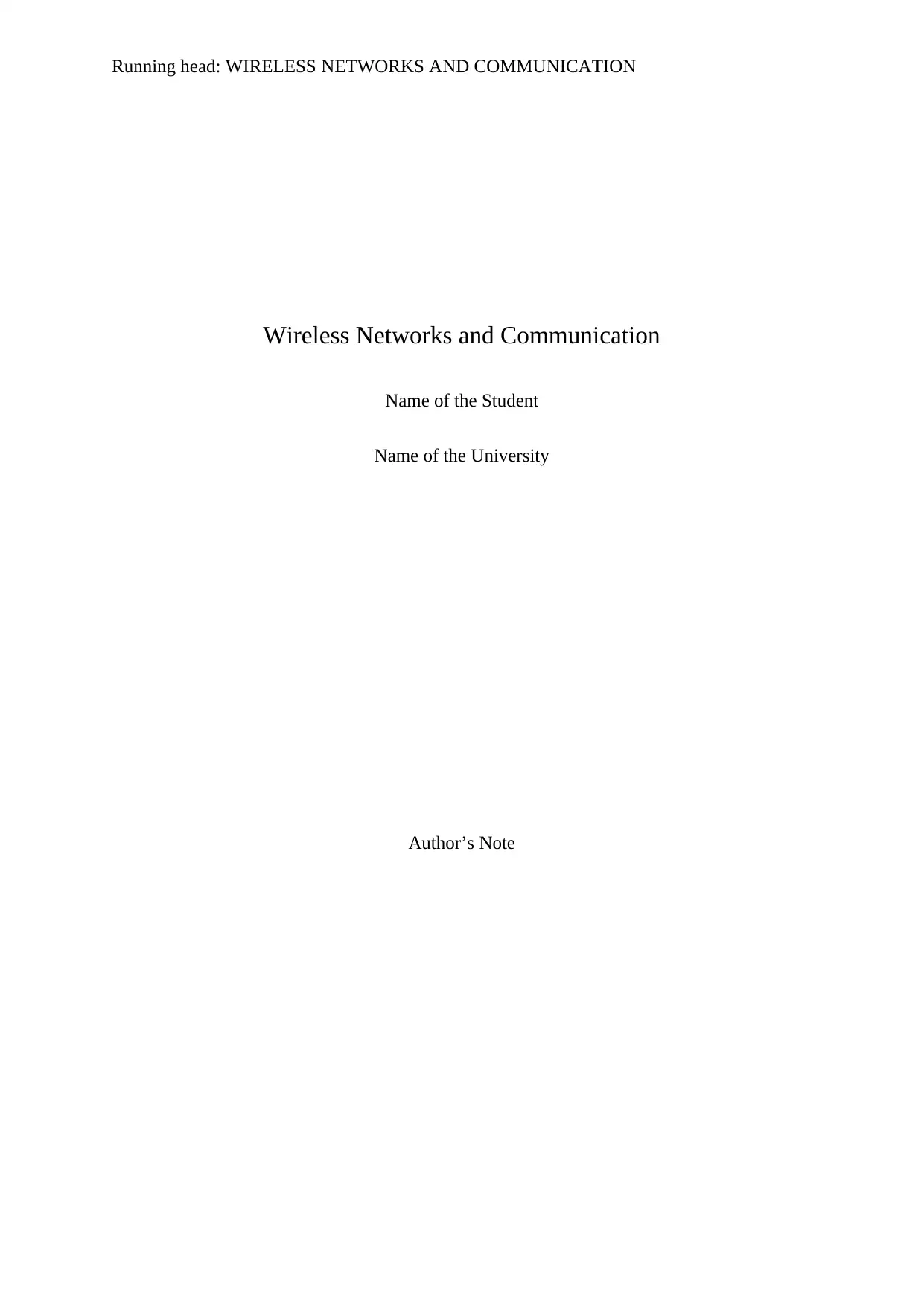
Running head: WIRELESS NETWORKS AND COMMUNICATION
Wireless Networks and Communication
Name of the Student
Name of the University
Author’s Note
Wireless Networks and Communication
Name of the Student
Name of the University
Author’s Note
Paraphrase This Document
Need a fresh take? Get an instant paraphrase of this document with our AI Paraphraser
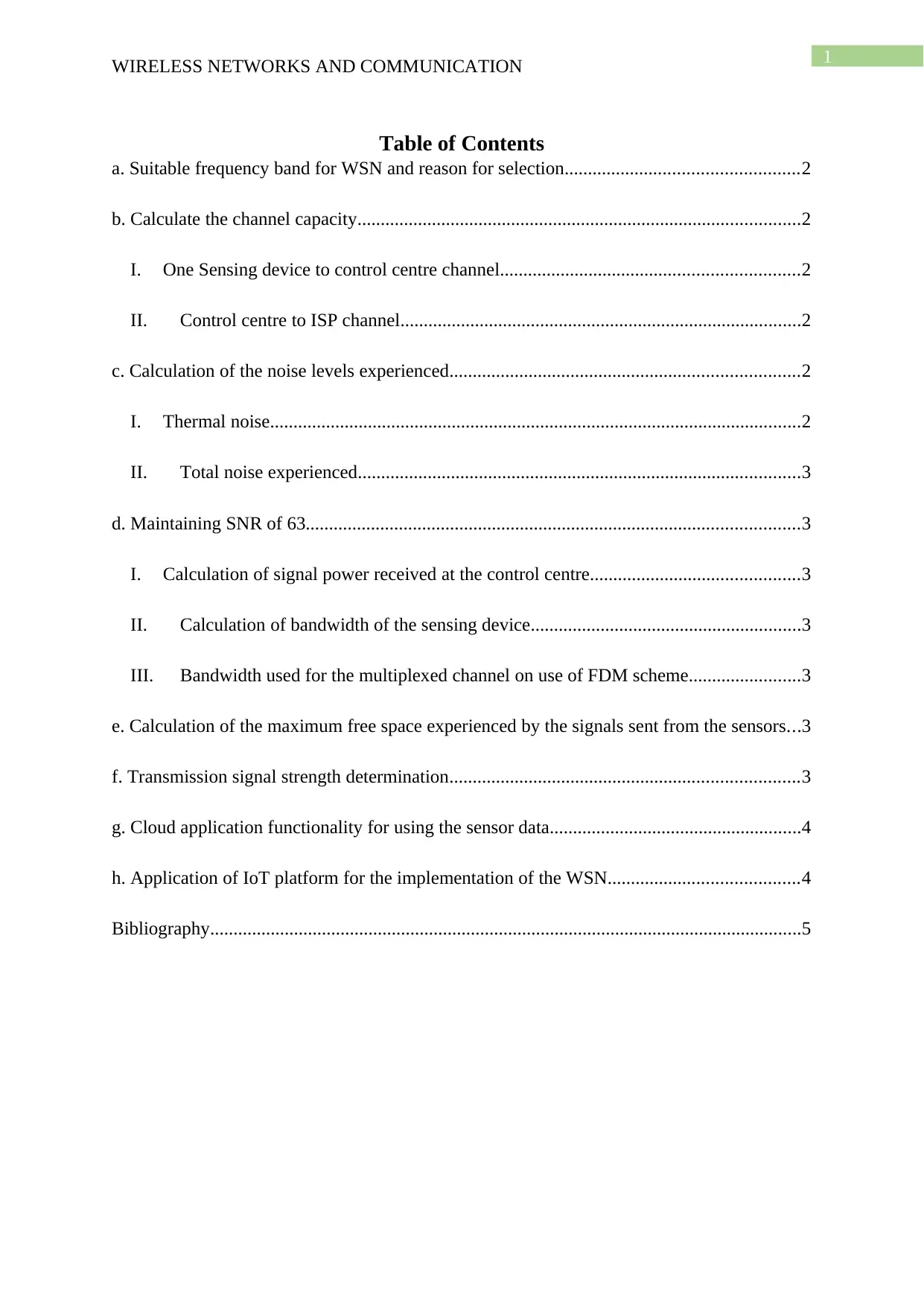
1
WIRELESS NETWORKS AND COMMUNICATION
Table of Contents
a. Suitable frequency band for WSN and reason for selection..................................................2
b. Calculate the channel capacity...............................................................................................2
I. One Sensing device to control centre channel................................................................2
II. Control centre to ISP channel......................................................................................2
c. Calculation of the noise levels experienced...........................................................................2
I. Thermal noise..................................................................................................................2
II. Total noise experienced...............................................................................................3
d. Maintaining SNR of 63..........................................................................................................3
I. Calculation of signal power received at the control centre.............................................3
II. Calculation of bandwidth of the sensing device..........................................................3
III. Bandwidth used for the multiplexed channel on use of FDM scheme........................3
e. Calculation of the maximum free space experienced by the signals sent from the sensors...3
f. Transmission signal strength determination...........................................................................3
g. Cloud application functionality for using the sensor data......................................................4
h. Application of IoT platform for the implementation of the WSN.........................................4
Bibliography...............................................................................................................................5
WIRELESS NETWORKS AND COMMUNICATION
Table of Contents
a. Suitable frequency band for WSN and reason for selection..................................................2
b. Calculate the channel capacity...............................................................................................2
I. One Sensing device to control centre channel................................................................2
II. Control centre to ISP channel......................................................................................2
c. Calculation of the noise levels experienced...........................................................................2
I. Thermal noise..................................................................................................................2
II. Total noise experienced...............................................................................................3
d. Maintaining SNR of 63..........................................................................................................3
I. Calculation of signal power received at the control centre.............................................3
II. Calculation of bandwidth of the sensing device..........................................................3
III. Bandwidth used for the multiplexed channel on use of FDM scheme........................3
e. Calculation of the maximum free space experienced by the signals sent from the sensors...3
f. Transmission signal strength determination...........................................................................3
g. Cloud application functionality for using the sensor data......................................................4
h. Application of IoT platform for the implementation of the WSN.........................................4
Bibliography...............................................................................................................................5
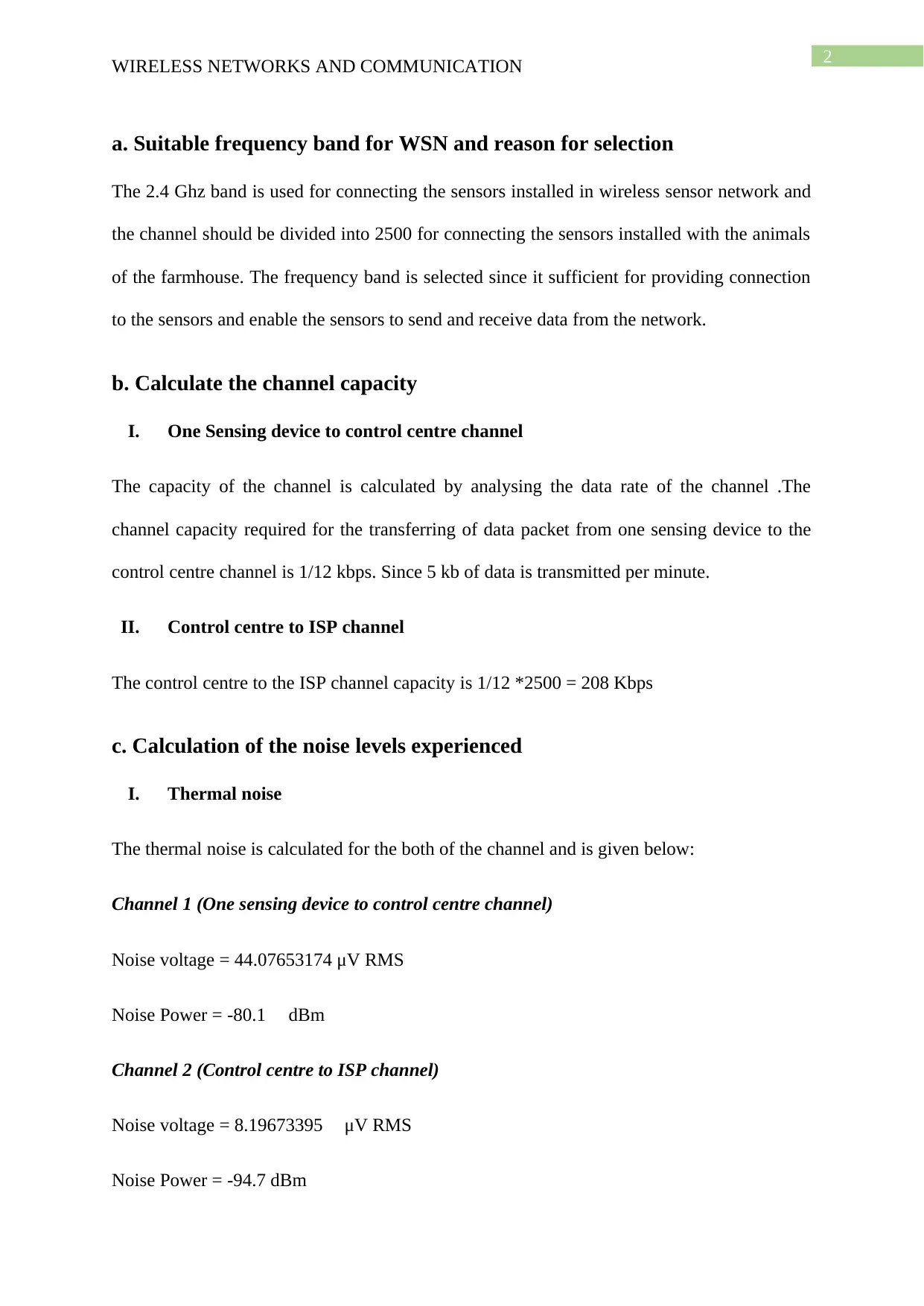
2
WIRELESS NETWORKS AND COMMUNICATION
a. Suitable frequency band for WSN and reason for selection
The 2.4 Ghz band is used for connecting the sensors installed in wireless sensor network and
the channel should be divided into 2500 for connecting the sensors installed with the animals
of the farmhouse. The frequency band is selected since it sufficient for providing connection
to the sensors and enable the sensors to send and receive data from the network.
b. Calculate the channel capacity
I. One Sensing device to control centre channel
The capacity of the channel is calculated by analysing the data rate of the channel .The
channel capacity required for the transferring of data packet from one sensing device to the
control centre channel is 1/12 kbps. Since 5 kb of data is transmitted per minute.
II. Control centre to ISP channel
The control centre to the ISP channel capacity is 1/12 *2500 = 208 Kbps
c. Calculation of the noise levels experienced
I. Thermal noise
The thermal noise is calculated for the both of the channel and is given below:
Channel 1 (One sensing device to control centre channel)
Noise voltage = 44.07653174 μV RMS
Noise Power = -80.1 dBm
Channel 2 (Control centre to ISP channel)
Noise voltage = 8.19673395 μV RMS
Noise Power = -94.7 dBm
WIRELESS NETWORKS AND COMMUNICATION
a. Suitable frequency band for WSN and reason for selection
The 2.4 Ghz band is used for connecting the sensors installed in wireless sensor network and
the channel should be divided into 2500 for connecting the sensors installed with the animals
of the farmhouse. The frequency band is selected since it sufficient for providing connection
to the sensors and enable the sensors to send and receive data from the network.
b. Calculate the channel capacity
I. One Sensing device to control centre channel
The capacity of the channel is calculated by analysing the data rate of the channel .The
channel capacity required for the transferring of data packet from one sensing device to the
control centre channel is 1/12 kbps. Since 5 kb of data is transmitted per minute.
II. Control centre to ISP channel
The control centre to the ISP channel capacity is 1/12 *2500 = 208 Kbps
c. Calculation of the noise levels experienced
I. Thermal noise
The thermal noise is calculated for the both of the channel and is given below:
Channel 1 (One sensing device to control centre channel)
Noise voltage = 44.07653174 μV RMS
Noise Power = -80.1 dBm
Channel 2 (Control centre to ISP channel)
Noise voltage = 8.19673395 μV RMS
Noise Power = -94.7 dBm
⊘ This is a preview!⊘
Do you want full access?
Subscribe today to unlock all pages.

Trusted by 1+ million students worldwide

3
WIRELESS NETWORKS AND COMMUNICATION
II. Total noise experienced
Noise power = -174.8 dBm
d. Maintaining SNR of 63
I. Calculation of signal power received at the control centre
SNR = Psignal / Pnoise = μ/σ
=> 63 = Psignal / -174.8 dBm
=> Psignal = 63 * 174.8 dBm
II. Calculation of bandwidth of the sensing device
1/12 kbps
III. Bandwidth used for the multiplexed channel on use of FDM scheme
1/12 * 2500 = 208.33 khz
= 0.20 Mhz
e. Calculation of the maximum free space experienced by the signals sent
from the sensors
FSPL = 20 log10(d) + 20 log10(f) + 20 log10(4π/c) – Gt - Gr
Free Space Path Loss: 85.96 dB
f. Transmission signal strength determination
The transmission length of the signal for attenuation and fading of the signal power for the
propagation of the data packet in the control centre to the sensor
WIRELESS NETWORKS AND COMMUNICATION
II. Total noise experienced
Noise power = -174.8 dBm
d. Maintaining SNR of 63
I. Calculation of signal power received at the control centre
SNR = Psignal / Pnoise = μ/σ
=> 63 = Psignal / -174.8 dBm
=> Psignal = 63 * 174.8 dBm
II. Calculation of bandwidth of the sensing device
1/12 kbps
III. Bandwidth used for the multiplexed channel on use of FDM scheme
1/12 * 2500 = 208.33 khz
= 0.20 Mhz
e. Calculation of the maximum free space experienced by the signals sent
from the sensors
FSPL = 20 log10(d) + 20 log10(f) + 20 log10(4π/c) – Gt - Gr
Free Space Path Loss: 85.96 dB
f. Transmission signal strength determination
The transmission length of the signal for attenuation and fading of the signal power for the
propagation of the data packet in the control centre to the sensor
Paraphrase This Document
Need a fresh take? Get an instant paraphrase of this document with our AI Paraphraser
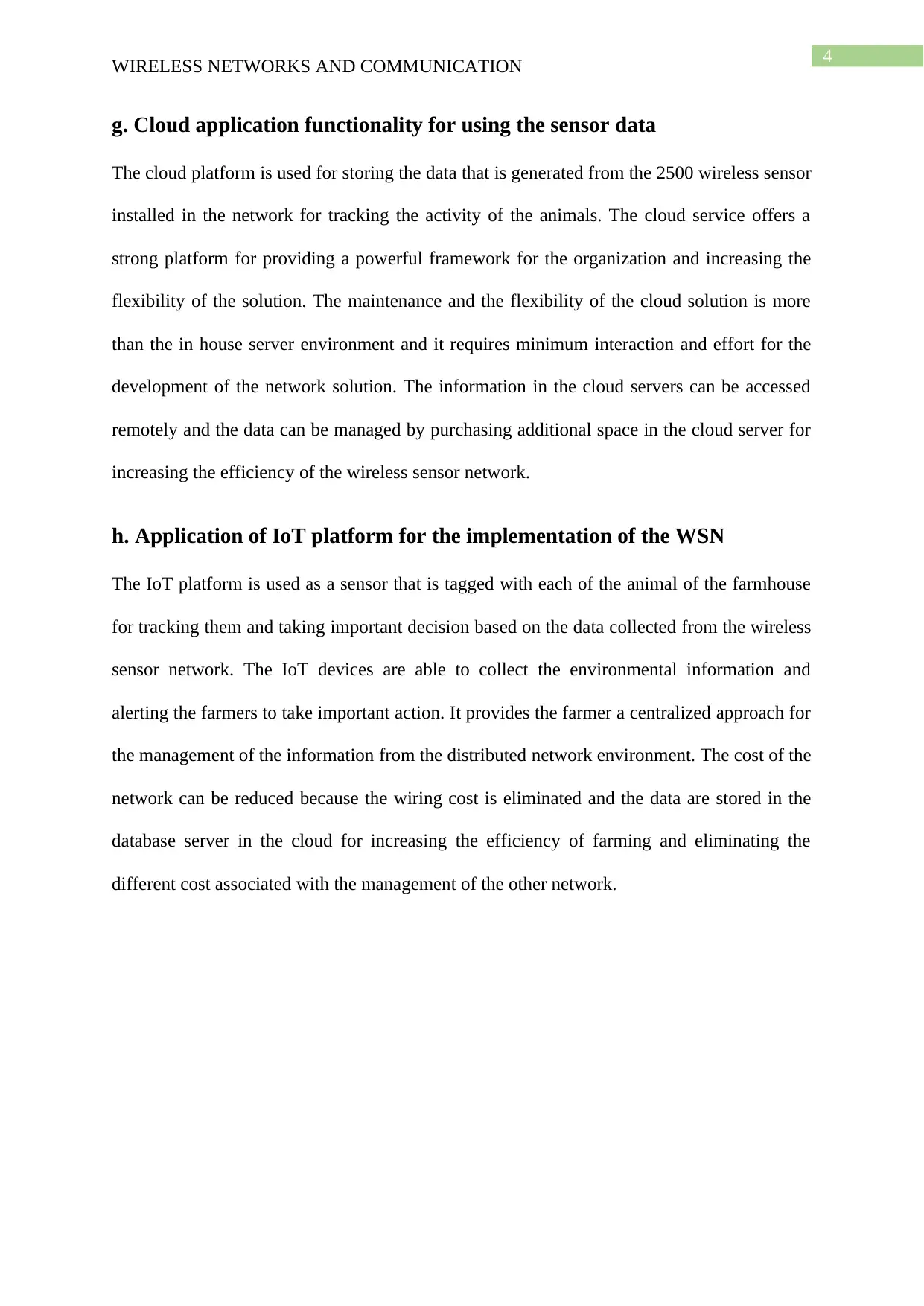
4
WIRELESS NETWORKS AND COMMUNICATION
g. Cloud application functionality for using the sensor data
The cloud platform is used for storing the data that is generated from the 2500 wireless sensor
installed in the network for tracking the activity of the animals. The cloud service offers a
strong platform for providing a powerful framework for the organization and increasing the
flexibility of the solution. The maintenance and the flexibility of the cloud solution is more
than the in house server environment and it requires minimum interaction and effort for the
development of the network solution. The information in the cloud servers can be accessed
remotely and the data can be managed by purchasing additional space in the cloud server for
increasing the efficiency of the wireless sensor network.
h. Application of IoT platform for the implementation of the WSN
The IoT platform is used as a sensor that is tagged with each of the animal of the farmhouse
for tracking them and taking important decision based on the data collected from the wireless
sensor network. The IoT devices are able to collect the environmental information and
alerting the farmers to take important action. It provides the farmer a centralized approach for
the management of the information from the distributed network environment. The cost of the
network can be reduced because the wiring cost is eliminated and the data are stored in the
database server in the cloud for increasing the efficiency of farming and eliminating the
different cost associated with the management of the other network.
WIRELESS NETWORKS AND COMMUNICATION
g. Cloud application functionality for using the sensor data
The cloud platform is used for storing the data that is generated from the 2500 wireless sensor
installed in the network for tracking the activity of the animals. The cloud service offers a
strong platform for providing a powerful framework for the organization and increasing the
flexibility of the solution. The maintenance and the flexibility of the cloud solution is more
than the in house server environment and it requires minimum interaction and effort for the
development of the network solution. The information in the cloud servers can be accessed
remotely and the data can be managed by purchasing additional space in the cloud server for
increasing the efficiency of the wireless sensor network.
h. Application of IoT platform for the implementation of the WSN
The IoT platform is used as a sensor that is tagged with each of the animal of the farmhouse
for tracking them and taking important decision based on the data collected from the wireless
sensor network. The IoT devices are able to collect the environmental information and
alerting the farmers to take important action. It provides the farmer a centralized approach for
the management of the information from the distributed network environment. The cost of the
network can be reduced because the wiring cost is eliminated and the data are stored in the
database server in the cloud for increasing the efficiency of farming and eliminating the
different cost associated with the management of the other network.
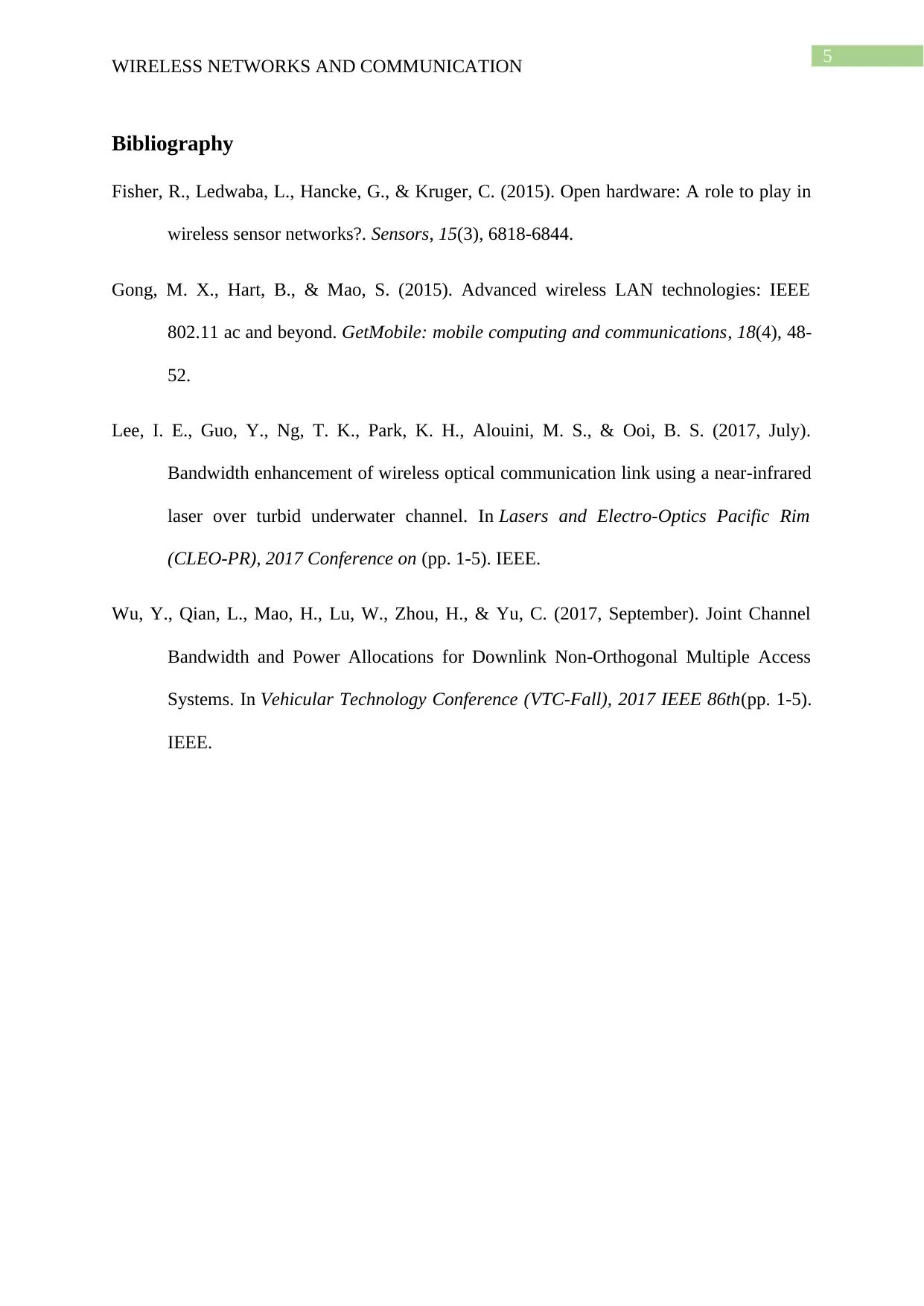
5
WIRELESS NETWORKS AND COMMUNICATION
Bibliography
Fisher, R., Ledwaba, L., Hancke, G., & Kruger, C. (2015). Open hardware: A role to play in
wireless sensor networks?. Sensors, 15(3), 6818-6844.
Gong, M. X., Hart, B., & Mao, S. (2015). Advanced wireless LAN technologies: IEEE
802.11 ac and beyond. GetMobile: mobile computing and communications, 18(4), 48-
52.
Lee, I. E., Guo, Y., Ng, T. K., Park, K. H., Alouini, M. S., & Ooi, B. S. (2017, July).
Bandwidth enhancement of wireless optical communication link using a near-infrared
laser over turbid underwater channel. In Lasers and Electro-Optics Pacific Rim
(CLEO-PR), 2017 Conference on (pp. 1-5). IEEE.
Wu, Y., Qian, L., Mao, H., Lu, W., Zhou, H., & Yu, C. (2017, September). Joint Channel
Bandwidth and Power Allocations for Downlink Non-Orthogonal Multiple Access
Systems. In Vehicular Technology Conference (VTC-Fall), 2017 IEEE 86th(pp. 1-5).
IEEE.
WIRELESS NETWORKS AND COMMUNICATION
Bibliography
Fisher, R., Ledwaba, L., Hancke, G., & Kruger, C. (2015). Open hardware: A role to play in
wireless sensor networks?. Sensors, 15(3), 6818-6844.
Gong, M. X., Hart, B., & Mao, S. (2015). Advanced wireless LAN technologies: IEEE
802.11 ac and beyond. GetMobile: mobile computing and communications, 18(4), 48-
52.
Lee, I. E., Guo, Y., Ng, T. K., Park, K. H., Alouini, M. S., & Ooi, B. S. (2017, July).
Bandwidth enhancement of wireless optical communication link using a near-infrared
laser over turbid underwater channel. In Lasers and Electro-Optics Pacific Rim
(CLEO-PR), 2017 Conference on (pp. 1-5). IEEE.
Wu, Y., Qian, L., Mao, H., Lu, W., Zhou, H., & Yu, C. (2017, September). Joint Channel
Bandwidth and Power Allocations for Downlink Non-Orthogonal Multiple Access
Systems. In Vehicular Technology Conference (VTC-Fall), 2017 IEEE 86th(pp. 1-5).
IEEE.
⊘ This is a preview!⊘
Do you want full access?
Subscribe today to unlock all pages.

Trusted by 1+ million students worldwide
1 out of 6
Related Documents
Your All-in-One AI-Powered Toolkit for Academic Success.
+13062052269
info@desklib.com
Available 24*7 on WhatsApp / Email
![[object Object]](/_next/static/media/star-bottom.7253800d.svg)
Unlock your academic potential
© 2024 | Zucol Services PVT LTD | All rights reserved.


